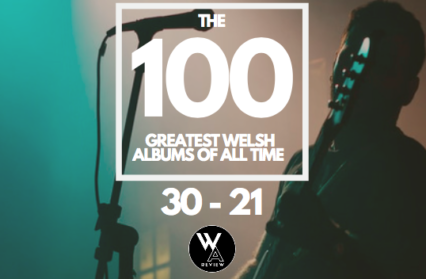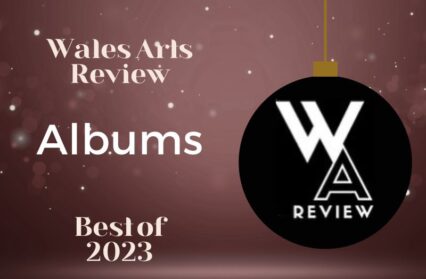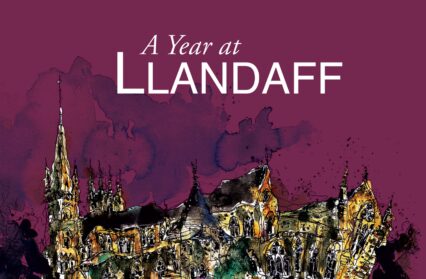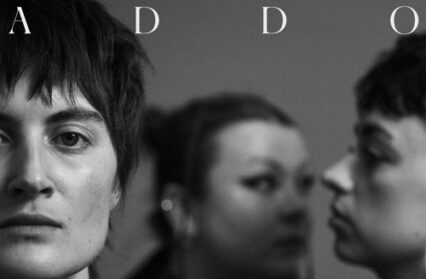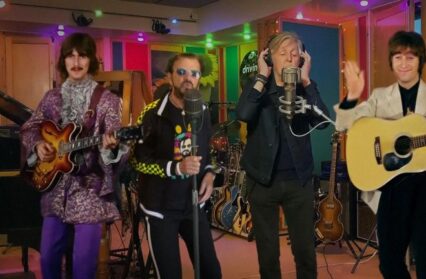Join Wales Arts Review every Friday as we count down the one hundred greatest Welsh albums of all time, as chosen by the Wales Arts Review team and friends of the Review. Week eight sees us count down from 30-21 of the greatest Welsh albums, taking in new wave, pop, prog-rock, Italo-disco, alt-indie and funk.
30
Radiator
(1997, Creation)
What to pick from an album teeming with highlights? Maybe the West Coast harmony saturated post-punk power balladry of ‘She’s Got Spies’ (‘but it’s not quite like the KGB, you see’)? A song that effortlessly manages to be both profoundly moving and profoundly exciting all at the same time. Perhaps the dysfunctional, stoned pop of ‘The International Language of Screaming’ and ‘Play It Cool’? Certainly the swooping, mariachi-flavoured ballad, ‘Demons’ – a mordant cousin of Fuzzy Logic’s ‘If You Don’t Want Me to Destroy You.’ But in all probability, you would have to say that it is the closing triptych of ‘Down a Different River’, ‘Download’ and ‘Mountain People,’ that really places Radiator among the greats. It is here that the Americana influences which would suffuse much of their later work blends seamlessly with malfunctioning electronica and the Welsh Pastoralism of the quieter moments of Fuzzy Logic. ‘Stuffed to the eyeballs with God knows what… I think I might have just snorted a blizzard,’ begins Gruff like some sort of politically-engaged Noel Gallagher – before granting us a decidedly more pained perspective on the Great Britpop Cocaine Epidemic to that of the nonsense rhyming offered up on ‘Champagne Supernova’. ‘Download,’ and ‘Mountain People’ meanwhile evoke the sound of the population of the Welsh countryside vainly calling out against the materialism of consumer society. ‘There are people who think and people who don’t / And the people who don’t are the ones who have most,’ sings Gruff in a voice that sounds as old and as plaintive as the landscape he is singing about. ‘They don’t care about you and me, obviously/ No fat chance/ We’re the Mountain People.’
29
Scritti Politti
Cupid & Psyche 85
(1985, Universal)
The route from Green Garside’s earliest records to the mechanised perfection of Cupid and Psyche ’85 was a long and strange one. The songs of Scritti Politti in their first incarnation in the late 1970s are scratchy, intense affairs that evoke the environment of all-night, speed-fuelled debates in a Camden squat that produced them. This period of Garside’s life and artistic endeavour was brought to an abrupt halt when he sustained a serious anxiety attack in early 1980, at which point he returned to Wales to recuperate. It was at this time that he discovered the rapture of black pop and soul music, and as a means of persuading his fellow band members that they should in future take this as their inspiration, he wrote down his ideas. The resulting manuscript ran to thousands of words – the basis of a book, he later suggested, about the state and politics of popular music. The recorded outcome of this conversion was the first Scritti Politti LP, Songs to Remember, in 1982. Green closes the record with ‘The “Sweetest Girl”’, a gorgeous, reggae-lite tune that lopes over the beat of a home organ drum machine, but it would be Madness, not Scritti Politti, who had a hit with the song four years later. Familiarity with these songs would have been no preparation for the single that emerged in February 1984 and which would provide a template for the new sound of Scritti Politti. Even the intro of ‘Wood Beez (Pray like Aretha Franklin)’ represented a huge leap forward in confidence: sledgehammer drums, keyboard stabs and bursts of white noise; a synth bass and precision-engineered hi-hat part; and a guitar riff that owes more to Shalamar than any of the post-punk bands Scritti Politti were usually bracketed with. And this was all in the first sixty seconds. When the vocal came in, Green’s voice was recognisable from earlier records but almost nothing else was. The difference, clearly, was a budget that allowed for a lot of studio time, but also the investment of some serious technological expertise. Green’s new bandmates were David Gamson (keyboards) and Fred Maher (drums), two New Yorkers who revelled in the newfound freedoms of digital recording and sampling, and the single was produced by Arif Mardin whose work with – yes – Aretha Franklin and latterly Chaka Khan (‘We Can Work It Out’ and ‘I Feel For You’) Green had admired.
28
John Cale
Fear
(1974, Island)
John Cale’s fourth solo studio album opens with one of his best ever songs, “Fear is a Man’s Best Friend”, a riotous, bluesy anthem that stretches and reaches to a climax of primal scream-type discordance and piano clanging that simultaneously seems to be funny and terrifying, like Derek and Clive meets Terry Riley. It is a starling, euphoric, exposing start to a record full of bold, confident songwriting. The writing is enhanced by Cale’s core troup of this period, including Brian Eno on synths and twiddly knobs and Roxy Music’s Phil Manzanera lending a full and precise guitar throughout. It’s a tight, focussed record, which the opener doesn’t really set you up for. But that’s not to say it’s without a spontaneous soulful core. Quite the opposite. There is a shimmering, longing gospel vibe to tracks like “Buffalo Ballet” and the brilliant lullaby-tinged “Ship of Fools”. You can feel songs like “Barracuda” and “Gun” in some way are in dialogue with Bowie’s Diamond Dogs (1974) and Aladdin Sane (1973), with T-Rex’s Electric Warrior (1971), and particular his old band mate Lou Reed’s Rock n Roll Animal and Sally Can’t Dance (both 1974). Perhaps the most impactful element of Fear is that Cale seems to be having a great time making it. It comes out of the grooves of the vinyl like a vapour. “Emily” has him replete in Tin Pan Alley songsmithery, and closer “Momama Scuba” has him in full on experimental glam rock mode. Fear is the perfect fusion of all the things that make British music of the first half of the seventies still so enduring.
27
Gruff Rhys
Babelsberg
(2018, Rough Trade)
The albums of Gruff Rhys, which incorporate a range of musical genres in a kaleidoscopic fashion, retain their freshness precisely because the influences that structure them evolve with each successive release. His fifth album, Babelsberg (2018) highlights that Rhys’s approach is not simply a means of showing off versatility but instead allows him to mingle (or contrast) various musical styles with his carefully observed lyrics. The album captures the insidious sicknesses of an Americana whose musical styles it sneakily co-opts in order to scrutinise consumerism, corporate greed and the dangers of apathy. While the songs are not overtly political, they do express a sense of numbed disbelief at recent global events. Rhys’s lyrics have always gleefully undermined pretension and exposed duplicity, but here they have a sharper edge. The cynical tone of the tracks might lend the album an air of isolated grumbling, but Babelsberg avoids this by incorporating the BBC National Orchestra of Wales into several tracks. The individual melodies of fragmentation and despair gain a sense of collective scope and power, demonstrating that pessimism hasn’t diminished Rhys’s ambitious style. Gruff Rhys has remained a key figure and a formative influence in Welsh music for several decades and Babelsberg highlights precisely why his music remains relevant and influential. It continues to traverse the musical landscape, crossing stylistic boundaries and bringing something different home every time.
26
Neon Neon
Stainless Style
(2008, Lex Records)
Introducing John DeLorean. He’s a smooth-talking, 80s yuppie and possibly the world’s first playboy engineer – founder of the DeLorean Motor Company (and hence creator of Doc and Marty’s infamous time machine)… he’s also from the future. No, the John DeLorean caricature conjured here might not really exist. At least not outside of the confines of Gruff Rhys and LA hip-hop darling Boom Bip’s head-spinning concept album, Stainless Style. The term “genre-defying” has been bandied about a lot by music critics for the last twenty years and more, but – truly – Stainless Style takes the biscuit. A wild joy ride which mixes in the sights and smells of fluorescent 80s luxe living, this record is – in the broadest sense – an electro-pop galivant through many real instances of John DeLorean’s partying and philandering. Sonically it soars through shades of hip-hop, disco, Italo-pop and electro. With look-ins from a wide variety of musical greats (from Cate Le Bon to The Strokes), this album is a heady, silly and masterfully crafted dive into a nostalgia-tinged past with an ear to the future. By its final track, you may just feel – as this critic does – that sonic cohesion is, all in all, pretty overrated.
25
Silent Forum
Everything Solved at Once
(2019, Libertino)
It’s difficult to think of a more musically literate album to have come out of Wales in recent years than Silent Forum’s debut. The band seem just as versed in new romantic tension as they are in noughties indy vernacular established by bands like the Klaxons and the Rapture. They have a live looseness on this album. It was a brave and correct decision to not reign them in in the studio. The magic of Everything Solved at Once can be found in the winding jammed out grooves of “How We Faked the Moon Landings” and ‘Kind of Blue”. Frontman Richard Wiggins is a classic of the type, and has all the balls-out arthouse confidence that aligns him with some of the greats like David Byrne and Steve Strange. On stage, he commands the space, and he does the same in the sonic realm of the album. He is an arresting, dominating presence, and the music, cool, clever, mysterious and ice blue chic, washes around him. There is a freeform feel to the band at times, like they’re in danger of going off and on and on. But it’s not a danger, it’s a thrill. Songs like “Credit to Mark Sinker” are more like Robert Wyatt bouncing off 80s Miles Davis. The exquisite euphoria of the album is in the fact you’re never quite sure if the band is going to hold on to its feverous ride. And all the time Wiggins is in the middle like some kind of shaman. Everything Solved at Once closes with the sublime “A Pop Act”, a song so good, and so excellently performed, it would sit easily with the best things the Cure or the Cult or Simple Minds ever did.
24
Man
2oz of Plastic with a Hole in the Middle
(1969, Sanctuary)
The great psychedelic prog rock statement to come from Wales was from the first incarnation of Swansea icons, Man. It begins with the melodic sweeps and crashing cymbals and chanting and seagull noises familiar to all students of prog with the full twelve minutes of “Prelude/The Storm”, a Floydian glide through analogue soundscapes and “out there” atmospherics; and it ends with the rollicking riff of “Brother Arnold’s Red and White Striped Tent”. Guitarists Deke Leonard and Micky Jones are holding nothing back here, and it’s a remarkably confident album of studio trickery for a band still in their earliest stages of development. Pye Records made the strange decision to assign them John Schroeder as producer, previously an Ivor Novello Award-winning writer of easy listening songs. You can hear some of that softness in the third movement of “Prelude/The Storm” and some of the surprising turns on the record are down to the incongruity of raggedy-arse rock players from Swansea and Schroeder. But the hippy-dippy nonsense is shredded almost as soon as it establishes itself. “It Is As It Must Be” hears the band more like the blues rock live outfit they would go on to remain for decades to come on the festival circuit. There are flashes of Cream, The Doors, but most notably, on tracks like “Spunk Box” and “It Is As It Must Be” they are doing a great impression of Black Sabbath two years before Black Sabbath’s debut album came out. It may be dated in parts, but 2 Oz. still rocks, and still rolls. One of the great rock albums of the earliest years of great rock albums.
23
Marina and the Diamonds
The Family Jewels
(2010, 679 Recordings)
You’d be hard pressed to find a more confident and accomplished pop debut than The Family Jewels, the album that announced the mercurial writing and performing talent that is Marina Diamandis. Back then, in 2010, she was Marina and the Diamonds, the Diamonds being her fans rather than her band. Since then she’s dropped that second, glittering part of her name, more as recognition that those Diamonds have grown up now and don’t necessarily need the anchor of an empowering gesture. But back then it was a club, and if you were never a Diamond listening back on this album can feel like eavesdropping on an intimate interaction between inspirational leader and devoted followers. But it’s all the richer experience for it, in a strange way. There is a great deal of love on the record, but more importantly, hook after hook after hook. Diamandis’ story is an exemplar of shrewd determination to make it in “the business”, one of a carefully curated stage persona and the mind of someone focused on learning the art of writing top notch pop songs. You’ll never be disappointed with a Marina album if you’re in the market for full, joyful, unpretentious pop, but her debut is a thing of real wonder. There is not an inch of this album that isn’t layered with lush synths and keyboards, every passing second is a beautifully curated set of melodic turns all facing the service of the song at hand. From “I Am Not a Robot” to “Hollywood” to “Numb”, Marina walks us through everything she has learned on her journey to this point. But there is restraint too – she’s a canny craftswoman as well as a sensual, playful singer. The Family Jewels is a bona fide classic and stands tall as a treasure trove of pop greatness in a genre that is often swamped with all style and little substance.
22
Datblygu
Libertino
(2018, Ankstmusic)
Libertino was the album that enabled Wales to finally catch up with Datblygu. Wales recognised them as avant-garde trailblazers, and much of its appeal to a new audience has to do with the Al Edwards and Gorwel Owen’s layered production of. Datblygu found itself in the middle of dance culture and it seemed natural that David R. Edwards would become an MC to Welsh language culture. Libertino captures the energy and optimism of that time. Its collaborative nature- featuring artists such as John Griffiths (Llwybr Llaethog) Fiona Owen (Plant bach Ofnus/ Eirin Peryglus) Peredur ap Gwynedd, (later Pendulum) felt like a gesture to of a broad community of like-minded Welsh artists. In this album there are obvious totemic songs such as ‘Can i Gymru’ with its acerbic take on Welsh institutions, ‘parch’ or a culture of conservatism as well as plaintive ‘Maes E’ which serves as both a love song and document of the Iraq war and rave culture. But take your time to linger over the masterpiece that is ‘Rauschgiftsüchtige’ (German for drug addict). This poppy musical collage combines puns in Welsh, political assertions, an attack on British Telecom (the only telephone provider at the time) all built around a chorus of ‘Laurie Anderson’ iterated many times. Libertino still feels like a shamanic guide to a new imagined Wales.
21
Alex Dingley
Beat the Babble
(2018, Libertino)
A long time friend of Cate Le Bon, Dingley travelled to California’s West Coast to record the Beat the Babble album with her, Tim Presley, and Samur Khouja. This, his third record, was for three years available in the US only via Birth Records before being brought to these shores in 2018 thanks to a ressiue from Libertino. A remarkable record, it’s very short, less than half an hour long but loses no power due to such brevity; if anything the honest emotion and musical sparseness is made more direct, cutting right through. Between The Sheets is an honest expression of vulnerability and loneliness over slightly wonky piano; Lovely Life to Leave is the song to bellow at 2am in the morning when deep in grief. Take that from someone who knows. Displaying honest emotion in a most naked raw form, Dingley hides nothing of what goes on in his soul, which in turn provides a tremendous comfort.
To find out our picks for 100-91, 90-81, 80-71, 70-61, 60-51. 50-41 and 40-31 in the Wales Arts Review 100 Greatest Welsh Albums of All Time just follow the links.
*
Join us next week for 20-11 in the Wales Arts Review 100 Greatest Welsh Albums of All Time.
*
List compiled by Wales Arts Review and friends of the Review. Words by Cath Holland, Tilly Foulkes, Caragh Medlicott, John Lavin, Gray Taylor, Nerys Williams, Craig Austin, Jude Rogers, Jack Boyce, Gareth Smith, Tomos Williams, and Gary Raymond.


